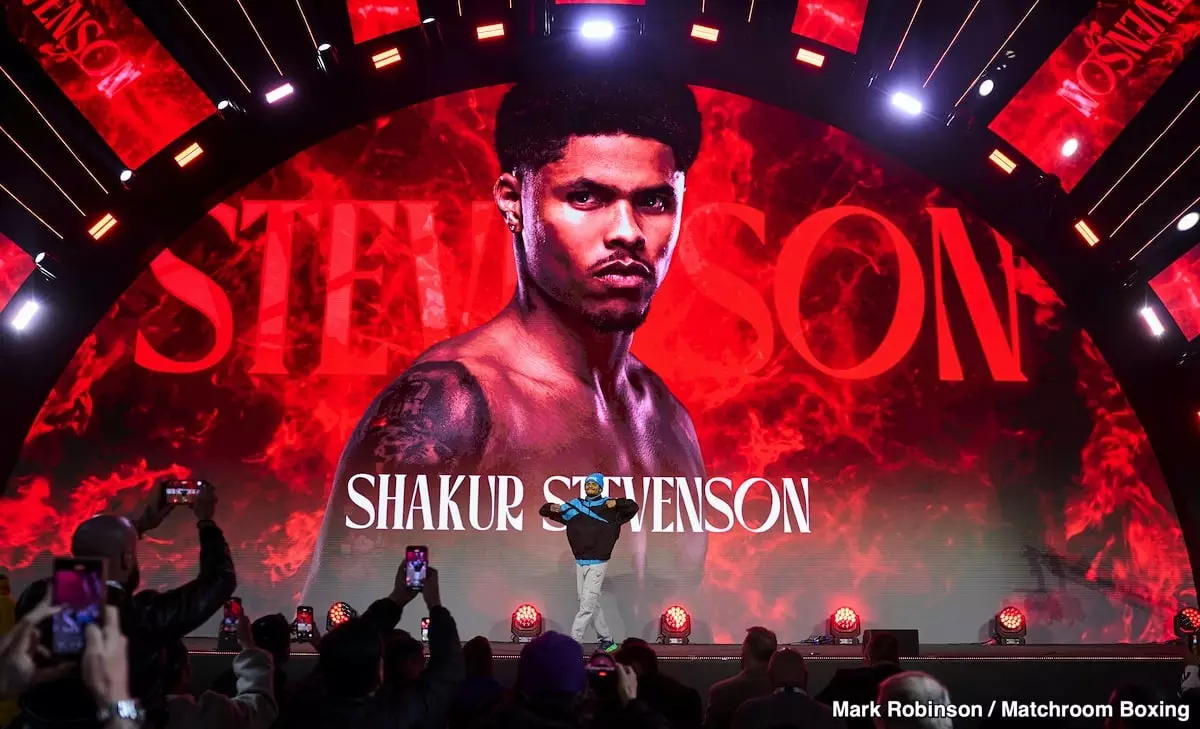In the high-octane world of professional boxing, few experiences can cut as deep as feeling overlooked by a fighter you idolize. Shakur Stevenson, a promising talent, has been vocal about his disappointment with Vasily Lomachenko’s refusal to step into the ring with him since Stevenson ascended to the lightweight category two years ago. For Stevenson, this isn’t merely about a missed opportunity; it’s a personal rebuke that has festered over time. The reality is that for someone who held Lomachenko in high regard, the sentiment of being “ducked” can sting more than any punch thrown in the ring.
Lomachenko, a seasoned three-division world champion, seems to have calculated that fighting Stevenson isn’t worth his time, especially given Stevenson’s relatively low profile at the time. However, it raises a critical question: does popularity determine a fighter’s worthiness for a match? Boxing has often placed premium value on name recognition, but such a mindset risks overlooking the raw talent and promise that fighters like Stevenson bring into the ring.
Contextualizing the Talent Gap
Stevenson’s frustrations reveal an underlying truth about his situation. While he boasts commendable skills, including impressive defensive maneuvers honed through years of experience as an elite amateur, there’s an unspoken gap in his offensive capabilities compared to Lomachenko. Despite having experienced a decline due to age and inactivity, Lomachenko remains a multifaceted threat in the ring. In recent memory, his performance against George Kambosos Jr. illuminated his offensive power, suggesting that he still holds enough advantage to potentially handle Stevenson in a bout.
Stevenson’s recent fight against Josh Padley, which took place on a low-profile undercard, further underlines the notion that he still has a mountain to climb. It seems perplexing that he would be buried in a less glamorous bout when he yearns for recognition as a future star. This struggle emphasizes the yearning that many young athletes feel for acknowledgment, but it also reveals a systemic issue within boxing’s promotional hierarchy. Shakur’s assertion that he feels disappointed in Lomachenko serves as a microcosm of a larger frustration many fighters endure throughout their careers.
Balancing Aspirations Against Reality
Chris Mannix’s inquiry about Stevenson’s feelings regarding potential fights serves as a poignant reminder of the psychological tensions in boxing. While it’s understandable that Stevenson wants to secure bouts with the likes of Lomachenko and Tank Davis—two names etched in the annals of modern boxing—the reality remains that high-profile matches often pivot upon the stars’ own timelines.
Stevenson’s revelation that he holds a strong sense of disappointment in Lomachenko—more so than with Davis—is revealing. He recognizes Lomachenko as a “legend” who set the bar high for him personally. The juxtaposition of admiration and dissatisfaction is a powerful emotional cocktail that can drive a fighter to elevate their game or, conversely, feel shackled by external circumstances.
This reflection on Lomachenko’s legacy, juxtaposed with current frustrations, illustrates a complex relationship that often defines sports. As champions ascend or descend in their careers, younger fighters are perpetually assessing their positioning in terms of legacy and ambition. Stevenson’s acknowledgment of Lomachenko’s prowess is not merely admiration; it illustrates the weight of expectation that young talents bear in a sport that continuously evolves.
Strategic Considerations and Future Matchups
The recent shift in Lomachenko’s career trajectory since 2023, marked by fewer fights against elite competitors like Devin Haney, raises speculation. It emphasizes the perception of a window closing for both fighters. One wonders if Lomachenko is truly reluctant to face Stevenson or if he’s simply prudently managing his resources in a sport where longevity is fragile.
If the two were to face off, the question of who would prevail becomes a thrilling yet complex debate. Stevenson undoubtedly has athletic potential, but his offensive repertoire has a notable limitation, a deficiency that seasoned fighters like Lomachenko can easily exploit. Lomachenko’s tactical capability to dissect opponents’ weaknesses places him in a series of favorable positions that could leave Stevenson vulnerable, regardless of their differences in youth and energy.
For Stevenson, the journey is far from over. He must navigate the labyrinth of expectations, talent, and opportunities, reminding not just himself but the boxing world of the potential that lies within. The fight against a perceived legend like Lomachenko could serve as a vital crucible for Stevenson, but will that fight materialize before it becomes a mere footnote in the annals of his career? In a sport defined by its unpredictability, only time will tell.

